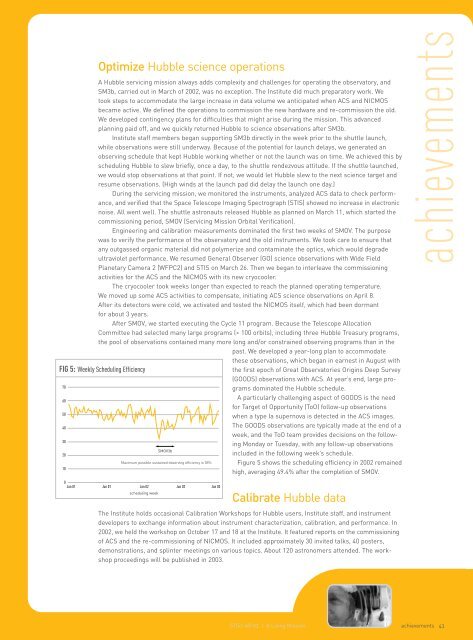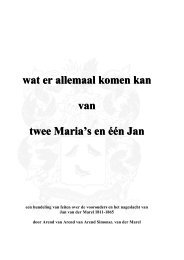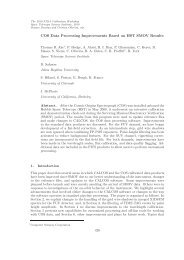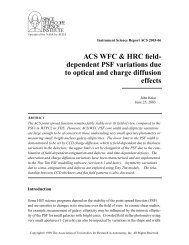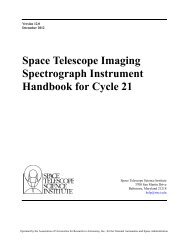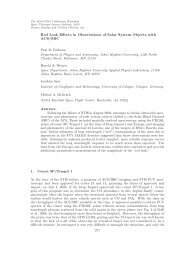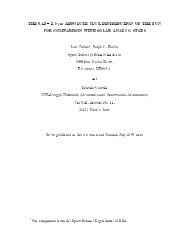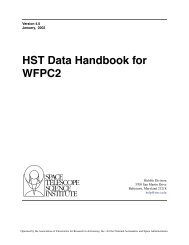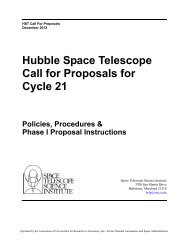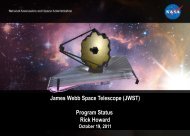STScI Annual Report 2002: A Living Mission
STScI Annual Report 2002: A Living Mission
STScI Annual Report 2002: A Living Mission
Create successful ePaper yourself
Turn your PDF publications into a flip-book with our unique Google optimized e-Paper software.
Optimize Hubble science operations<br />
A Hubble servicing mission always adds complexity and challenges for operating the observatory, and<br />
SM3b, carried out in March of <strong>2002</strong>, was no exception. The Institute did much preparatory work. We<br />
took steps to accommodate the large increase in data volume we anticipated when ACS and NICMOS<br />
became active. We defined the operations to commission the new hardware and re-commission the old.<br />
We developed contingency plans for difficulties that might arise during the mission. This advanced<br />
planning paid off, and we quickly returned Hubble to science observations after SM3b.<br />
Institute staff members began supporting SM3b directly in the week prior to the shuttle launch,<br />
while observations were still underway. Because of the potential for launch delays, we generated an<br />
observing schedule that kept Hubble working whether or not the launch was on time. We achieved this by<br />
scheduling Hubble to slew briefly, once a day, to the shuttle rendezvous attitude. If the shuttle launched,<br />
we would stop observations at that point. If not, we would let Hubble slew to the next science target and<br />
resume observations. (High winds at the launch pad did delay the launch one day.)<br />
During the servicing mission, we monitored the instruments, analyzed ACS data to check performance,<br />
and verified that the Space Telescope Imaging Spectrograph (STIS) showed no increase in electronic<br />
noise. All went well. The shuttle astronauts released Hubble as planned on March 11, which started the<br />
commissioning period, SMOV (Servicing <strong>Mission</strong> Orbital Verification).<br />
Engineering and calibration measurements dominated the first two weeks of SMOV. The purpose<br />
was to verify the performance of the observatory and the old instruments. We took care to ensure that<br />
any outgassed organic material did not polymerize and contaminate the optics, which would degrade<br />
ultraviolet performance. We resumed General Observer (GO) science observations with Wide Field<br />
Planetary Camera 2 (WFPC2) and STIS on March 26. Then we began to interleave the commissioning<br />
activities for the ACS and the NICMOS with its new cryocooler.<br />
The cryocooler took weeks longer than expected to reach the planned operating temperature.<br />
We moved up some ACS activities to compensate, initiating ACS science observations on April 8.<br />
After its detectors were cold, we activated and tested the NICMOS itself, which had been dormant<br />
for about 3 years.<br />
After SMOV, we started executing the Cycle 11 program. Because the Telescope Allocation<br />
Committee had selected many large programs (> 100 orbits), including three Hubble Treasury programs,<br />
the pool of observations contained many more long and/or constrained observing programs than in the<br />
past. We developed a year-long plan to accommodate<br />
these observations, which began in earnest in August with<br />
the first epoch of Great Observatories Origins Deep Survey<br />
(GOODS) observations with ACS. At year’s end, large programs<br />
dominated the Hubble schedule.<br />
A particularly challenging aspect of GOODS is the need<br />
for Target of Opportunity (ToO) follow-up observations<br />
when a type Ia supernova is detected in the ACS images.<br />
The GOODS observations are typically made at the end of a<br />
week, and the ToO team provides decisions on the following<br />
Monday or Tuesday, with any follow-up observations<br />
SMOV3b<br />
included in the following week’s schedule.<br />
Maximum possible sustained observing efficiency is 58%<br />
Figure 5 shows the scheduling efficiency in <strong>2002</strong> remained<br />
high, averaging 49.4% after the completion of SMOV.<br />
FIG 5: Weekly Scheduling Efficiency<br />
70<br />
60<br />
50<br />
40<br />
30<br />
20<br />
10<br />
0<br />
Jan 01 Jun 01 Jan 02 Jun 02 Jan 03<br />
scheduling week<br />
Calibrate Hubble data<br />
The Institute holds occasional Calibration Workshops for Hubble users, Institute staff, and instrument<br />
developers to exchange information about instrument characterization, calibration, and performance. In<br />
<strong>2002</strong>, we held the workshop on October 17 and 18 at the Institute. It featured reports on the commissioning<br />
of ACS and the re-commissioning of NICMOS. It included approximately 30 invited talks, 40 posters,<br />
demonstrations, and splinter meetings on various topics. About 120 astronomers attended. The workshop<br />
proceedings will be published in 2003.<br />
<strong>STScI</strong> AR 02 | A <strong>Living</strong> <strong>Mission</strong><br />
achievements<br />
achievements 43


